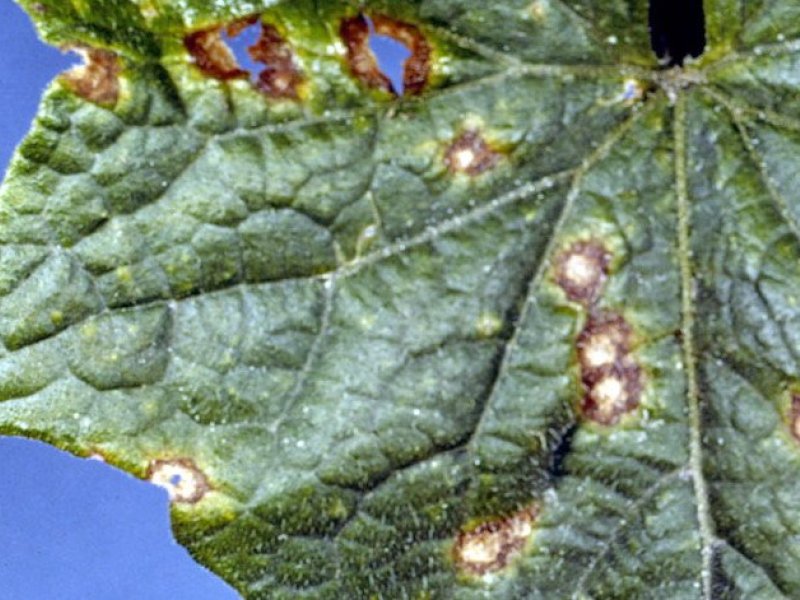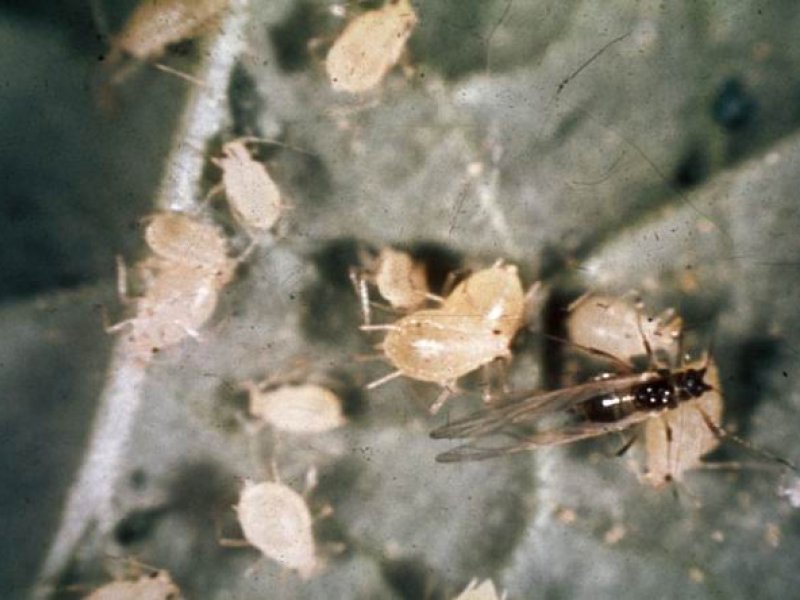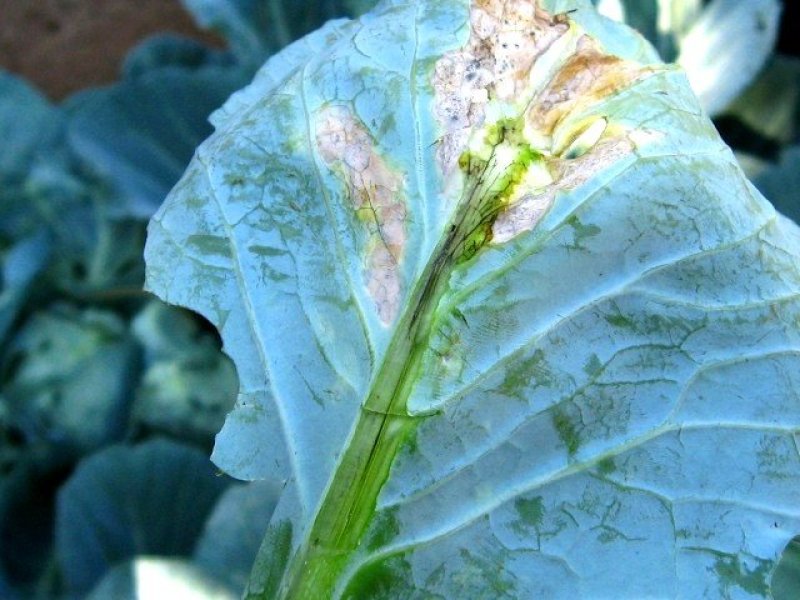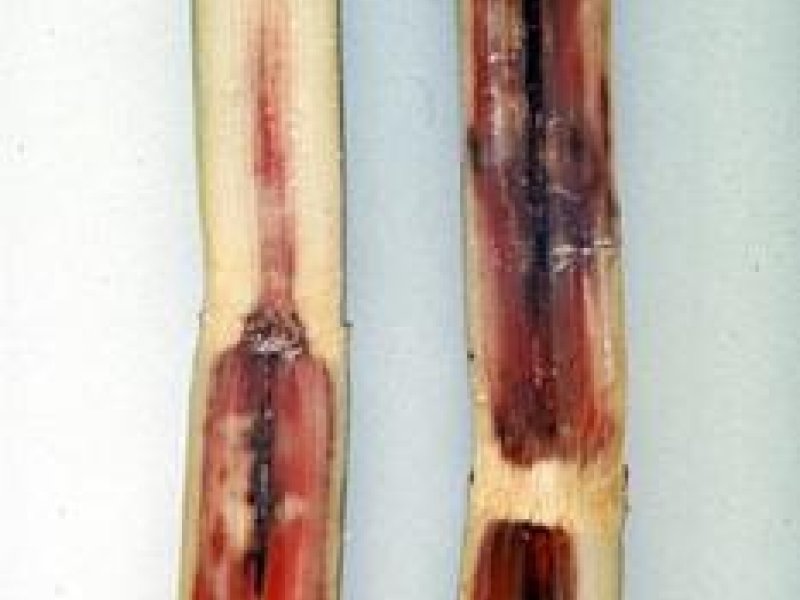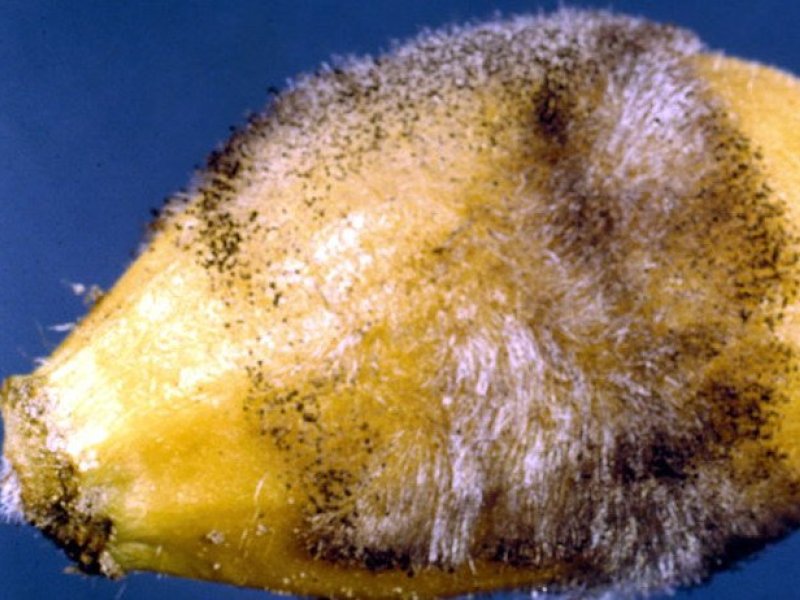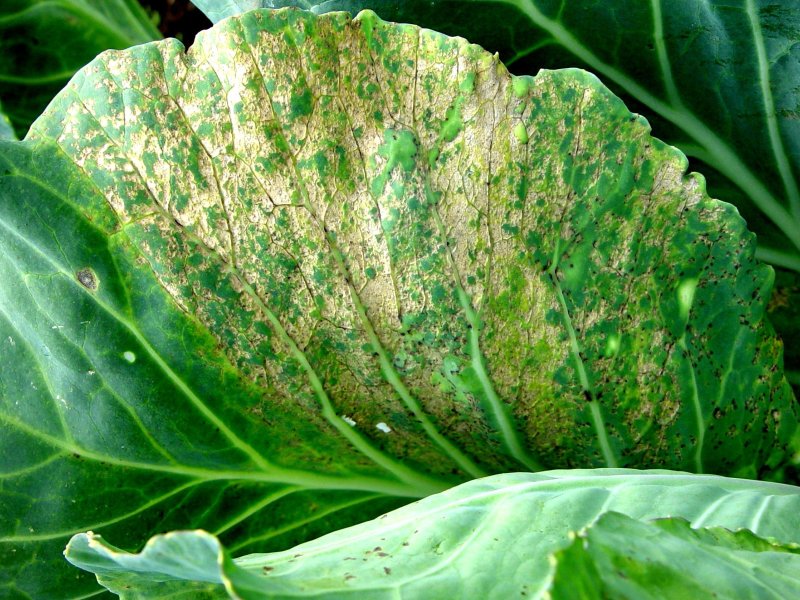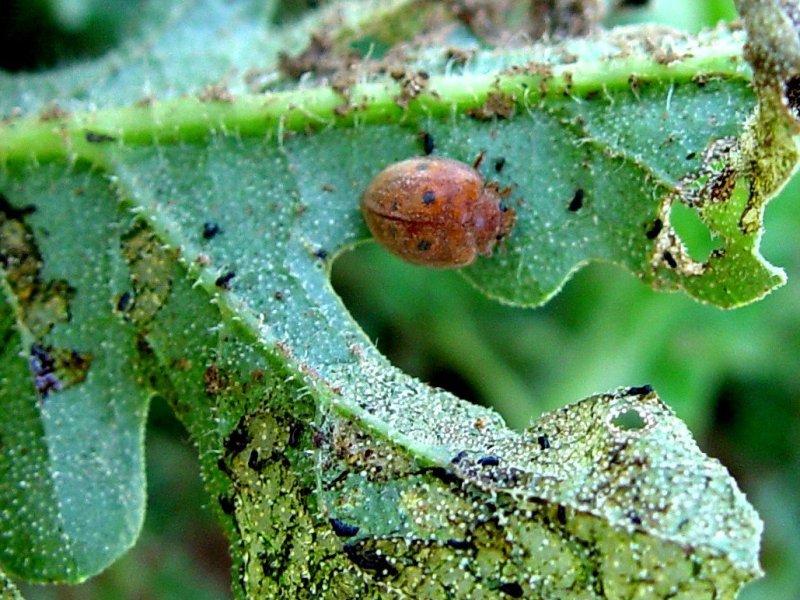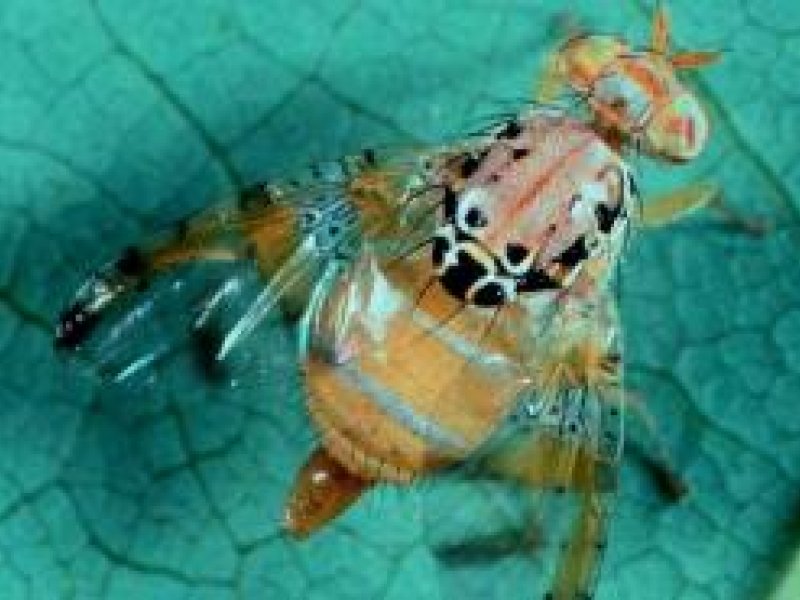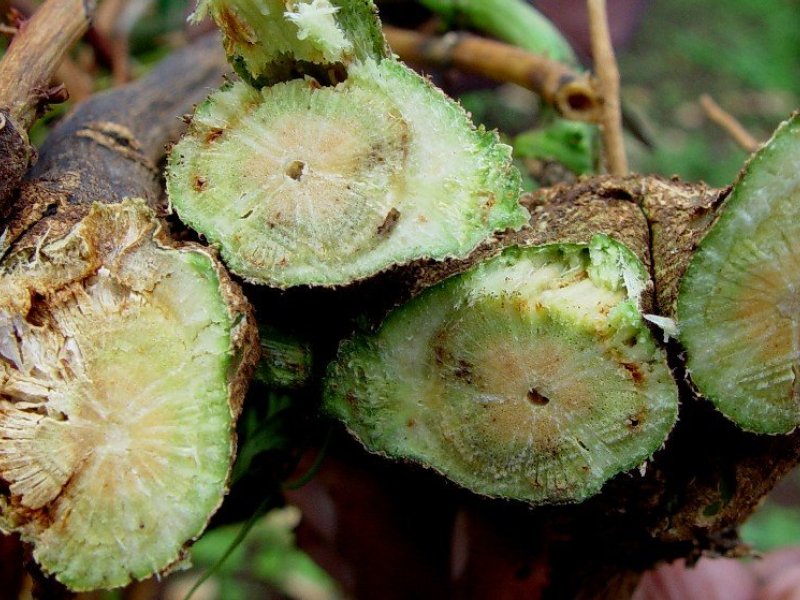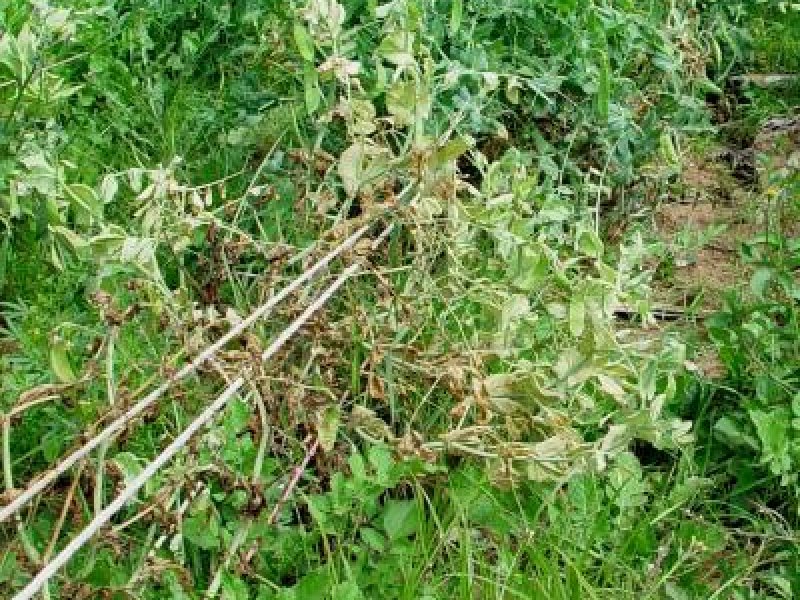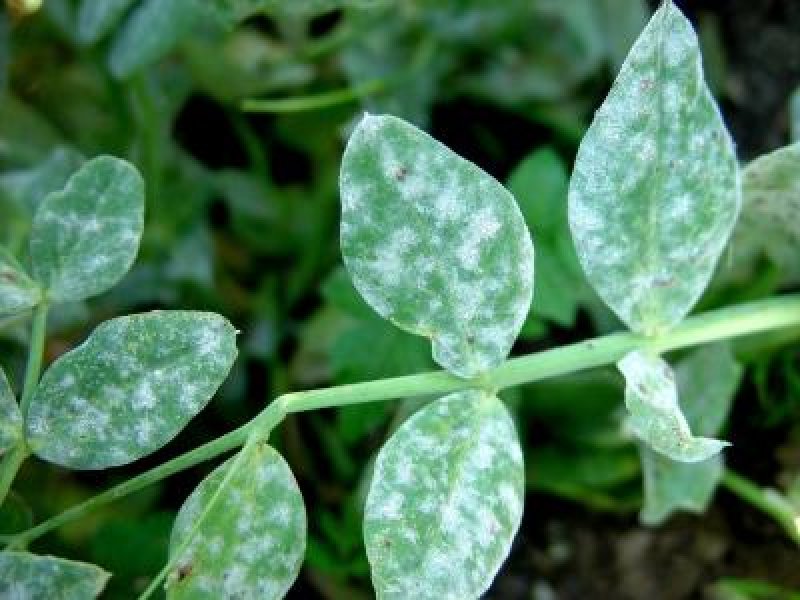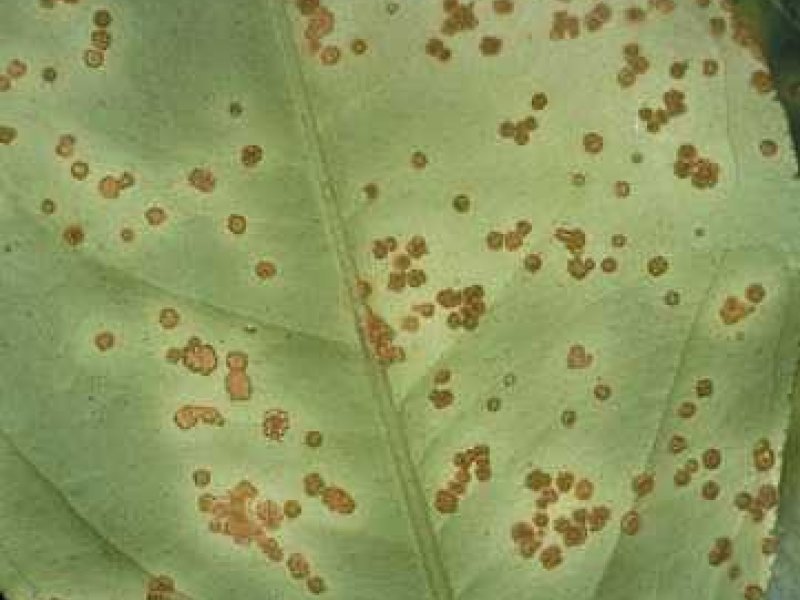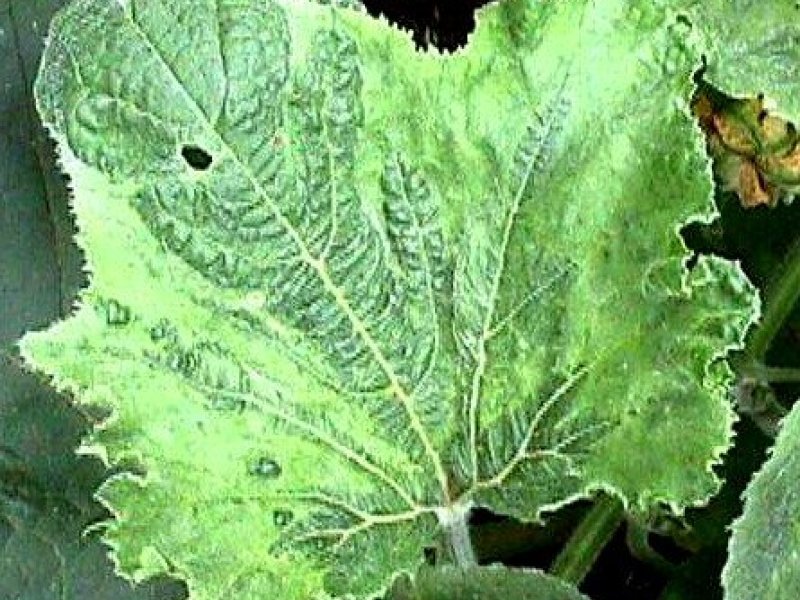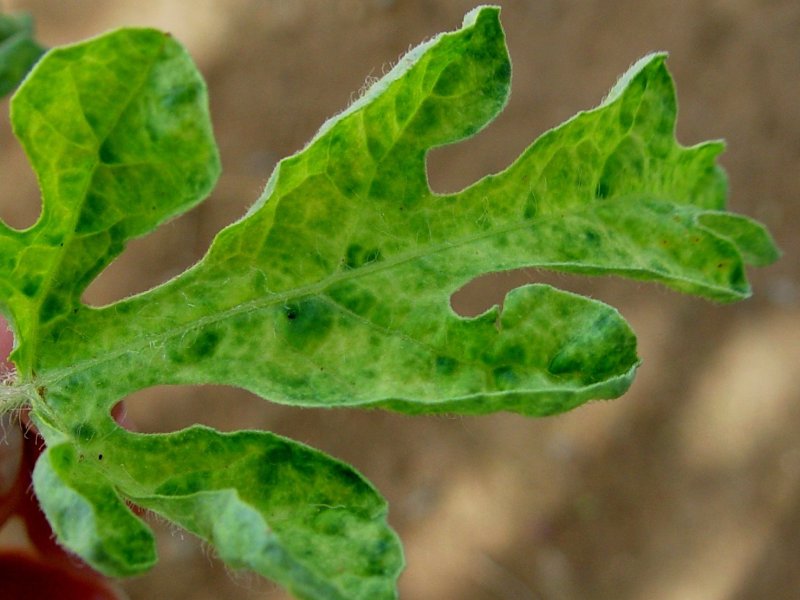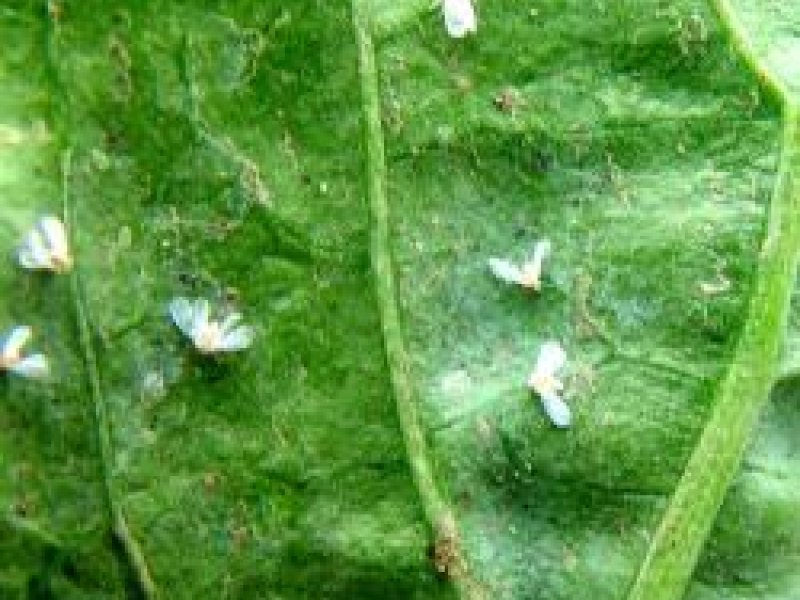|
Anthracnose (Colletotrichum lagenarium (= C. orbiculare)) It is a very destructive disease. It causes defoliation and lesions on the fruits. |
|
|
What to do:
|
|
Aphids (Aphis gossypii) Colonies of green to blackish aphids are found on tender shoots, mainly on the lower leaf surface, where they suck sap. Under heavy attack the growth of attacked shoots is stunted and leaves are curled and twisted. Aphids excrete honeydew, which leads to growth of sooty mould, and may also attract fruit flies. Aphids transmit virus diseases such as the watermelon mosaic virus to pumpkins.
|
|
|
What to do:
|
|
Gummy stem blight and black rot (Didymella bryoniae (= Mycosphaerella citrullina); Phoma cucurbitacearum) Circular to irregular spots on leaves. On centres of the spots pycnidia (fungal fruiting bodies) develop. The spots may tear and drop out giving the leaves a tattered appearance. Crown and runners turn pale-brown and then crack oozing a reddish gum. The affected areas are studded with pycnidia. Runners may be girdled and die. Affected fruits exhibit black, leathery, sunken spots and under moist conditions pycnidia develop at the centres. On butternut squash, large irregular areas of the fruit become bronzed with distinct concentric rings. Fruits are spotted and rot. Infected fruits have no commercial value. |
|
|
What to do:
|
|
Choanephora fruit rot (Choanephora cucurbitarum) C. cucurbitarum mostly attacks tissues that have been damaged by insects or mechanical means. Host tissues have a hairy appearance resulting from the tall fungal filaments that produce a cluster of brown spores (conidia) at their tips. |
|
|
What to do:
|
|
Downy mildew Symptoms on leaves appear as small, pale-yellow areas on upper leaf surface. Under humid conditions, a purplish, grey whitish growth may be seen on the underside of the yellowish spots. Affected leaves curl, shrivel and die. Most downy mildew fungi require cool weather for reproduction and development. This is not true of the cucurbit downy mildew fungus. Optimum temperature for infection is at 16 to 22°C . It can survive when temperatures are over 37.8°C . The most critical factor for infection is a film of moisture and / or long dew periods on leaves. |
|
|
What to do:
|
|
Epilachna beetle (Epilachna chrysomelina) Adults of the Epilachna beetle, also known as the African melon ladybird are 6 to 8 mm long, reddish in colour with a number of black spots on the wing cases. The larvae are 7 to 9 mm in length, soft and covered with dark coloured spines. They pupate on leaves. Both adults and larvae feed on the leaves leaving a fine net of veins. Damaged leaves shrivel and dry up. They may also gnaw stems and eat holes in fruits. These beetles are most likely to be a problem during establishment when plants are small; young plants can be entirely destroyed. Older plants can tolerate considerable leaf damage, but during flowering fruit set maybe affected. This beetle is a vector of squash mosaic virus. The Epilachna beetle attacks all cucurbits. They often fly into a crop from nearby crops.
|
|
|
What to do:
|
|
Fruit flies (Bactrocera cucurbitae, Dacusspp. and Ceratitis capitata) Fruit flies are important pests of cucurbits including pumpkins. Fruit flies pierce the fruits and lay eggs in them. The fruit fly maggots feed inside the fruit causing sunken, discoloured patches, distortions and open cracks. These cracks serve as entry points for fungi and bacteria, which cause fruit rot.
|
|
|
What to do:
|
|
Fusarium wilt (Fusarium oxysporum f.sp. niveum) It causes root rot and corky decay of the stem near ground level, leading to wilting and death. Inside wilted stems the vascular tissue may be discoloured. White to pinkish fungus mycelium may grow over affected tissue. Leaves of affected plants turn yellow and eventually wilt and die. It also causes loss of young plants through damping-off, or of older plants through successive wilting. If fruit has formed, it remains small and loose commercial value. Cucurbits are attacked at all stages of growth. When seedlings are invaded, they may damp-off and die. Older susceptible plants wilt initially, occasionally recover at night, but usually wilt quickly and die. In wet weather, a white or pinkish fungal growth develops on the surface of dead tissues. In advance stages of the disease, roots may decompose. |
|
|
What to do:
|
|
Powdery mildew Symptoms first develop as a whitish talcum-like powdery growth on upper leaf surface. The powdery growth is composed of fungal spore mass. These areas covered by white powdery growth may enlarge and join up to cover both lower and upper leaf surfaces. Severely affected leaves dry, turn brown and become brittle. Vines can be also attacked. Secondary effects of the disease include sun-burning and premature ripening of fruits. |
|
|
What to do:
|
|
Scab (Cladosporium cucumerinum) It attacks all aboveground plant parts. Initial symptoms on leaves appear as light water-soaked or pale green spots. The spots are numerous and can appear on and between veins. Elongate spots may develop on petioles and stems. The spots later turn grey to white and become angular. The fine veinlets in the spots may be brown and are distinct against a white background. Dead leaf tissue cracks and breaks away until the whole leaf is ragged. Fruits can be attacked at all stages of growth. However, young fruits are most susceptible. Plant tissue near the spots may produce sap, initially watery but later becomes gummy to hard. The fruit spots are cankerous and with time become darker, sunken until a pronounced cavity is formed. Under moist weather, a dark-green velvety layer of fungal growth appears on the cavities. The fungus survives in crop debris, soil and on seed. It is spread by insects, farm tools and wind. The disease is most severe at 100% relative humidity and at relatively cool temperatures (21-25°C ). Its host range includes cantaloupe, gherkin, muskmelon, pumpkin, squash and watermelon. |
|
|
What to do:
|
|
Virus diseases Many important virus diseases affect cucurbits. These include: Cucumber mosaic cucumovirus (CMV) Watermelon mosaic 2 potyvirus (WMV-2) Watermelon mosaic 1 potyvirus Zucchini yellow mosaic potyvirus (ZYMV) Squash leaf curl bigeminivirus (SLCV) Cucumber mosaic virus It is not seed transmitted except through seed of perennial wild cucumber (Echinocytis lobata) and chickweed (Stellaria media). It is mechanically transmitted and in nature it is spread by various species of aphids. It has a very extensive host range including such varied species as bananas, carrots, cowpeas, lupine, lilies, onions, passion fruit, potatoes and tomatoes. Watermelon mosaic virus This virus is mechanically transmitted and also spread by several species of aphids. It is not seed transmitted. Its host range is primarily restricted to cucurbits although one of its strains infects peas. Squash mosaic virus It is mechanically transmitted. It is transmitted through seeds of melons and squash. It is also transmitted by spotted, striped and banded cucumber beetles, which attack cucumbers in the Americas. The Epilachna beetle (Epilachna chrysomelina) a pest of cucumber in Africa, is also vector of squash mosaic virus. Its host range includes cucurbits, peas, coriander, and salad chervil.
|
|
|
What to do:
|
|
Whiteflies (Bemisia tabaci) Whiteflies suck plant sap and excrete honeydew where moulds growth and may affect plant growth. However, the major damage is caused as vectors of various virus diseases, which cause considerable damage to cucurbits. |
|
|
What to do:
|
Geographical Distribution in Africa
Geographical distribution of Pumpkin in Africa. Updated on 5 July 2019. Source FAOSTAT
General Information and Agronomic Aspects
Pumpkin refers to certain varieties of Cucurbita moschata, C. maxima, and C. mixta. They are native to North America. These and other related cucurbits provide pumpkins and butternuts (Cucurbita moschata), squashes (C. maxima), gourds (C. argyrosperma), and zucchini or courgettes and ornamental gourds (C. pepo). Distinguishing them is often difficult. Pumpkins have long-running, bristled stems, large deeply-lobed leaves often containing white blotches and yellow or orange flowers separated into male and female types on the same plant. The fruit is variable in shape and colour but is often white, cream or green, containing about 70% flesh and several large white seeds.
Fruits, leaves and flowers of these cucurbits are used as vegetables, and their seeds are consumed roasted as a snack food. Pumpkin fruit contains 1% protein and 8% carbohydrates, and the dried seeds contain 23% protein, 21% carbohydrates and up to 50% oil, but little information is available about the nutritional characteristics of cooked leaves (Woomer and Imbumi, 2005).
There are numerous types and cultivars, which differ greatly in composition and therefore in their suitability for certain culinary uses. The younger leaves are collected and the outer tough skin of petioles (stalk of leaf) removed (together with the large leaf veins) then washed, chopped and boiled.
Immature and mature fruits of C. moschata are used as a blanched, steamed or fried vegetable and as an ingredient of soups. Various desserts are made from the fruits: steamed flesh with grated coconut and sugar, crisps made from steamed mashed flesh mixed with cassava flour, pumpkin custard, pumpkin pudding, pumpkin in coconut milk and sweet pumpkin paste. Ornamental gourds are cultivars of C. pepo with small, bitter and inedible fruits in many shapes, sizes and colours.The potential of the seeds as a source of vegetable fat and protein has not been fully exploited. Fresh seeds have been reported to be used as a vermifuge, and seed decoctions as diuretic and to reduce fevers.
The pumpkin has been much used as a medicine in Central and North America. It is a gentle and safe remedy for a number of complaints. The seeds are widely used as an anthelmintic. The complete seed, together with the husk, is used to remove tapeworms. They are especially useful effective as tapeworm treatment for children and pregnant women for whom stronger and toxic remedies are unsuitable. The seeds are ground into fine flour, then made into an emulsion with water and eaten. It is then necessary to take a purgative afterwards in order to expel the tapeworms or other parasites from the body. The fruit and seed decoctions have been reported to be used as diuretic and to reduce fevers, and are used for curing indigestion. The pulp is applied to burns and scalds, inflammation, abscesses and boils. It is also used in the treatment of migraine and neuralgia (Plants for a Future 2003; CAB 2006).
Recently a new pumpkin relative, butternut has captured the market in Kenya. It was originally imported from South Africa and sold at very high prices in the upper level market, but is now widely grown by small farmers. Butternut has smooth yellow-orange flesh, is very nutritious and is widely used cooked and mashed as baby food. As the price came down this vegetable has gained wide popularity all over the country.
Nutritive Value per 100 g of edible Portion
| Raw or Cooked Pumpkin |
Food Energy (Calories / %Daily Value*) |
Carbohydrates (g / %DV) | Fa t(g / %DV) | Protein (g / %DV) | Calcium (g / %DV) | Phosphorus (mg / %DV) | Iron (mg / %DV) | Potassium (mg / %DV) | Vitamin A (I.U) | Vitamin C (I.U) | Vitamin B 6 (I.U) | Vitamin B 12 (I.U) | Thiamine (mg / %DV) | Riboflavin (mg / %DV) | Ash (g / %DV) |
| Pumpkin cooked | 20.0 / 1% | 4.9 / 2% | 0.1 / 0% | 0.7 / 1% | 15.0 / 1% | 30.0 / 3% | 0.6 / 3% | 230.0 / 7% | 4992 IU / 100% | 4.7 / 8% | 0.0 / 2% | 0.0 / 0% | 0.0 / 2% | 0.1 / 5% | 0.6 |
| Pumpkin raw | 26.0 / 1% | 6.5 / 2% | 0.1 / 0% | 1.0 / 2% | 21.0 / 2% | 44.0 / 4% | 0.8 / 4% | 340 / 10% | 7385 IU / 148% | 9.0 / 15% | 0.1 / 3% | 0.0 / 0% | 0.1 / 3% | 0.1 / 6% | 0.8 |
*Percent Daily Values (DV) are based on a 2000 calorie diet. Your daily values may be higher or lower, depending on your calorie needs.
Climate conditions, soil and water management
Pumpkins and squashes (various Cucurbita spp.) are grown in the tropics from the lowlands up to 2500 m altitude. They are warm-season crops adapted to monthly mean temperatures of 18-27°C. C. maxima is the most tolerant of low temperatures, C. moschata and C. argyrosperma the least, with C. pepo intermediate. C. maxima and C. pepo have long been cultivated in temperate regions. Butternut appreciates part shade in very hot conditions, such as can be obtained when intercropped with other crops or grown under fruit trees.
Pumpkins and squashes respond very well to medium to heavy applications of compost or well- decomposed manure. They can be cultivated on almost any fertile, well-drained soil with a neutral or slightly acid reaction (pH 5.5 to 7). They are drought-tolerant, requiring relatively little water, and are sensitive to waterlogging. Excessive humidity is harmful because of the development of leaf diseases, so none of the species do well in the humid tropics.
Propagation and planting
Pumpkins and squashes are grown from seed. Seeds may be sown in containers and transplanted to the field when they are 10 cm high. Direct seeding of 2 to 3 seeds per hill is commonly practised. Trailing types are planted at distances of 2-3 m either way; the seed requirement is 2 to 3 kg/ha. The bushy types (mainly C. pepo) are planted closer, for example, plants spaced 60 to 120 cm in rows 1 to 1.5 m apart; the seed requirement is 3 kg/ha for pumpkin and 7 kg/ha for summer squash (C. pepo). Do not use seeds from plants where edible pumpkins and ornamental gourds are grown close together. Offspring will be bitter or even inedible.
Varieties of butternut available in Kenya
- "Butternut 401". It has resistance to powdery mildew
- "Bugle". It has resistance to powdery mildew.
- "Early Butternut F1". It has resistance to powdery mildew.
- "Ultra F1". It has resistance to Fusarium wilt and powdery mildew.
- "Waltham". It has resistance to powdery mildew.
Husbandry
Sole cropping is sometimes used for commercial production. Pumpkins and squashes are also planted in home gardens or mixed with field crops such as maize. Cultural practices to improve growth and development include the removal of growing tips (in trailing varieties) to check growth, and the bagging of fruits in paper to protect against fruit fly and other pests. Fruit setting may be stimulated by manual pollination. The fruit may rot when in contact with moist soil, so often cut grass or leaves are placed beneath the fruit.
Harvesting
Winter squashes and pumpkins are picked when mature in an once-over harvest or in several rounds, about 90 to 120 days after planting depending on variety. Pumpkins are considered to be among the most efficient of vegetable crops when evaluated on nutritional yield in relation to land area and labour needed. Indicative figures for seed yield of C. pepo are 400 to 1500 kg/ha. A valuable source of oil and protein is thus neglected if the seeds are left unutilised. In seed production, isolation between fields of different Cucurbita species is recommended, not only for reason of purity but also for obtaining maximum yields (pollen of other species may cause reduced fruit set).
Fresh Quality Specifications for the Market in Kenya
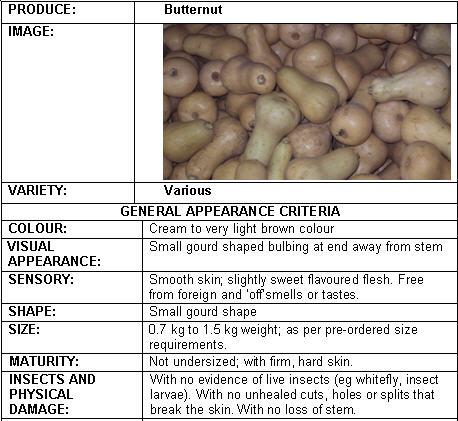 |
| © S. Kahumbu, Kenya |
Information on Pests
Pumpkin and butternut are affected by similar pests as other cucurbits; since they belong to the family Cucurbitacea, including melons, squash, zucchini (courgettes) and cucumber.
For more information on pests attacking cucurbits refer also to page on cucumber click here
Examples of Pumpkin Pests and Organic Control Methods
| Colonies of green to blackish aphids are found on tender shoots, mainly on the lower leaf surface, where they suck sap. Under heavy attack the growth of attacked shoots is stunted and leaves are curled and twisted. Aphids excrete honeydew, which leads to growth of sooty mould, and may also attract fruit flies. Aphids transmit virus diseases such as the watermelon mosaic virus to pumpkins.
What to do:
|
| Whiteflies suck plant sap and excrete honeydew where moulds growth and may affect plant growth. However, the major damage is caused as vectors of various virus diseases, which cause considerable damage to cucurbits. What to do:
|
| Epilachna beetle (Epilachna chrysomelina) Adults of the Epilachna beetle, also known as the African melon ladybird are 6 to 8 mm long, reddish in colour with a number of black spots on the wing cases. The larvae are 7 to 9 mm in length, soft and covered with dark coloured spines. They pupate on leaves. Both adults and larvae feed on the leaves leaving a fine net of veins. Damaged leaves shrivel and dry up. They may also gnaw stems and eat holes in fruits. These beetles are most likely to be a problem during establishment when plants are small; young plants can be entirely destroyed. Older plants can tolerate considerable leaf damage, but during flowering fruit set maybe affected. This beetle is a vector of squash mosaic virus. The Epilachna beetle attacks all cucurbits. They often fly into a crop from nearby crops.
What to do:
|
| Fruit flies (Bactrocera cucurbitae, Dacusspp. and Ceratitis capitata) Fruit flies are important pests of cucurbits including pumpkins. Fruit flies pierce the fruits and lay eggs in them. The fruit fly maggots feed inside the fruit causing sunken, discoloured patches, distortions and open cracks. These cracks serve as entry points for fungi and bacteria, which cause fruit rot.
What to do:
|
Information on Diseases
Pumpkin and butternut are affected by similar diseases as other cucurbits; since they belong to the family Cucurbitacea, including melons, squash, zucchini (courgettes) and cucumber.
For more information on pests attacking cucurbits refer also to page on cucumber click here
Examples of Pumpkin Diseases and Organic Control Methods
| Anthracnose (Colletotrichum lagenarium (= C. orbiculare)) It is a very destructive disease. It causes defoliation and lesions on the fruits. What to do:
|
| Circular to irregular spots on leaves. On centres of the spots pycnidia (fungal fruiting bodies) develop. The spots may tear and drop out giving the leaves a tattered appearance. Crown and runners turn pale-brown and then crack oozing a reddish gum. The affected areas are studded with pycnidia. Runners may be girdled and die. Affected fruits exhibit black, leathery, sunken spots and under moist conditions pycnidia develop at the centres. On butternut squash, large irregular areas of the fruit become bronzed with distinct concentric rings. Fruits are spotted and rot. Infected fruits have no commercial value. What to do:
|
| Fusarium wilt (Fusarium oxysporum f.sp. niveum) It causes root rot and corky decay of the stem near ground level, leading to wilting and death. Inside wilted stems the vascular tissue may be discoloured. White to pinkish fungus mycelium may grow over affected tissue. Leaves of affected plants turn yellow and eventually wilt and die. It also causes loss of young plants through damping-off, or of older plants through successive wilting. If fruit has formed, it remains small and loose commercial value. Cucurbits are attacked at all stages of growth. When seedlings are invaded, they may damp-off and die. Older susceptible plants wilt initially, occasionally recover at night, but usually wilt quickly and die. In wet weather, a white or pinkish fungal growth develops on the surface of dead tissues. In advance stages of the disease, roots may decompose. What to do:
|
| Choanephora fruit rot (Choanephora cucurbitarum) C. cucurbitarum mostly attacks tissues that have been damaged by insects or mechanical means. Host tissues have a hairy appearance resulting from the tall fungal filaments that produce a cluster of brown spores (conidia) at their tips. What to do:
|
| Symptoms first develop as a whitish talcum-like powdery growth on upper leaf surface. The powdery growth is composed of fungal spore mass. These areas covered by white powdery growth may enlarge and join up to cover both lower and upper leaf surfaces. Severely affected leaves dry, turn brown and become brittle. Vines can be also attacked. Secondary effects of the disease include sun-burning and premature ripening of fruits. What to do:
|
| Symptoms on leaves appear as small, pale-yellow areas on upper leaf surface. Under humid conditions, a purplish, grey whitish growth may be seen on the underside of the yellowish spots. Affected leaves curl, shrivel and die. Most downy mildew fungi require cool weather for reproduction and development. This is not true of the cucurbit downy mildew fungus. Optimum temperature for infection is at 16 to 22°C . It can survive when temperatures are over 37.8°C . The most critical factor for infection is a film of moisture and / or long dew periods on leaves. What to do:
|
| Scab (Cladosporium cucumerinum) It attacks all aboveground plant parts. Initial symptoms on leaves appear as light water-soaked or pale green spots. The spots are numerous and can appear on and between veins. Elongate spots may develop on petioles and stems. The spots later turn grey to white and become angular. The fine veinlets in the spots may be brown and are distinct against a white background. Dead leaf tissue cracks and breaks away until the whole leaf is ragged. Fruits can be attacked at all stages of growth. However, young fruits are most susceptible. Plant tissue near the spots may produce sap, initially watery but later becomes gummy to hard. The fruit spots are cankerous and with time become darker, sunken until a pronounced cavity is formed. Under moist weather, a dark-green velvety layer of fungal growth appears on the cavities. The fungus survives in crop debris, soil and on seed. It is spread by insects, farm tools and wind. The disease is most severe at 100% relative humidity and at relatively cool temperatures (21-25°C ). Its host range includes cantaloupe, gherkin, muskmelon, pumpkin, squash and watermelon. What to do:
|
| Many important virus diseases affect cucurbits. These include: Cucumber mosaic cucumovirus (CMV) Watermelon mosaic 2 potyvirus (WMV-2) Watermelon mosaic 1 potyvirus Zucchini yellow mosaic potyvirus (ZYMV) Squash leaf curl bigeminivirus (SLCV) Cucumber mosaic virus It is not seed transmitted except through seed of perennial wild cucumber (Echinocytis lobata) and chickweed (Stellaria media). It is mechanically transmitted and in nature it is spread by various species of aphids. It has a very extensive host range including such varied species as bananas, carrots, cowpeas, lupine, lilies, onions, passion fruit, potatoes and tomatoes. Watermelon mosaic virus This virus is mechanically transmitted and also spread by several species of aphids. It is not seed transmitted. Its host range is primarily restricted to cucurbits although one of its strains infects peas. Squash mosaic virus It is mechanically transmitted. It is transmitted through seeds of melons and squash. It is also transmitted by spotted, striped and banded cucumber beetles, which attack cucumbers in the Americas. The Epilachna beetle (Epilachna chrysomelina) a pest of cucumber in Africa, is also vector of squash mosaic virus. Its host range includes cucurbits, peas, coriander, and salad chervil.
What to do:
|
Information Source Links
- AIC (2003). Fruits and Vegetables Technical Handbook. Nairobi, Kenya.
- AVRDC International Cooperators' Factsheet on Cucurbits www.avrdc.org
- Aggie horticulture, Cucurbit Disorders. A Guide to the Identification of Common Problems. www.aggie-horticulture.tamu.edu
- Blay, E., Cudjoe, A. R., Braun, M. (Eds) (2000). Handbook of crop protection recommendations in Ghana: An IPM approach. Vol 2; vegetables. Plant Protection & Regulatory Services Directorate (PPRSD) and the Integrated Crop Protection Project, German Development Cooperation (GTZ).
- Bohlen, E. (1973). Crop pest in Tanzania and their control. Federal Agency for Economic Cooperation (BFE). Verlag Paul Parey. ISBN 3-489-64826-9.
- CABI. (2006). Crop Protection Compendium, 2006 Edition. © CAB International Publishing. www.cabi.org
- East African Seed Co. Ltd. Africa's Best Grower's Guide www.easeed.com
- Ecoport. The Consilience Engine. www.ecoport.org
- Ekesi, S., Billah, M.K. (Eds)(2006). A field guide to the management of economically important tephritid fruit flies in Africa. ICIPE, Nairobi, Kenya. ISBN: 92-9064-179-7.
- Ministry of Agriculture and Rural Development (Kenya) (MoARD) & Japan International Cooperation Agency (JICA) (2000). Local and Export Vegetables Growing Manual. Reprinted by Agricultural Information Resource Centre, Nairobi, Kenya. 274 pp.
- National Horticultural Research Station, Thika (1984). Horticultural Crops Protection Handbook. By C.M. Beije, S.T. Kanyangia, S.J.N. Muriuki, E.A. Otieno, A.A. Seif and A.M. Whittle. KEN/75/028 and KEN/80/017/
- Nutrition Data www.nutritiondata.com.
- Ostermann, H., Dreyer, M. (1995). Vegetables and grain legumes. In: The Neem tree Azadirachta indica A. Juss. and other meliaceous plants sources of unique natural products for integrated pest management, industry and other purposes. (1995). Edited by H. Schmutterer in collaboration with K. R. S. Ascher, M. B. Isman, M. Jacobson, C. M. Ketkar, W. Kraus, H. Rembolt, and R.C. Saxena. VCH. pp. 392-403. ISBN: 3-527-30054-6
- Sherf, A.F., Macnab, A.A. (1986). Vegetable Diseases and Their Control. 2nd. Edition. John Wiley & Sons Inc. USA. ISBN: 0-471-05860-2
- Summers, C.G. and Stapleton, J. J. (2002). Use of UV reflective mulch to delay the colonization and reduce the severity of Bemisia argentifolii (Homoptera: Aleyrodidae) infestations in cucurbits. Crop Protection. Volume 21. Pages 921-928.www.sciencedirect.com
- The Ohio State University Extension Vegetable Crops. VegNet, Online Library. vegnet.osu.edu
- UCANR. UC helps pumpkin farmers produce pumpkins without pesticides. October 2003 www.ucanr.org
- University of Georgia: College of Agricultural and Environmental Sciences, Department of Horticulture Vegetable Crops: Pumpkin.
- Woomer P. L. and Imbumi, M. (2005).Traditional Green Vegetables in Kenya. In Organic Resource Management in Kenya. Perspectives and Guidelines. Forum for Organic Resource Management and Agricultural Technologies (FORMAT).www.formatkenya.org
Contact Links
- For information on small scale farming techniques, seeds, equipment and insecticides(e.g. pyrethrum solution).HYGROTECH EAST AFRICA, LTD Region :KENYA / TANZANIA -Address :P.O.Box 41446, Nairobi, Tigoni Centre, Limuru Road, KENYA Phone :+254 (0) 20 205 3916, 0722 205 148. E-Mail: info@hygrotech.co.ke
- Corner Shop Nairobi:cornershop@africaonline.co.ke, +254 (0) 0716 905 486, (20) 2712268/9
- Green Dreams: info@organic.co.ke +254 (0) 724 781 971/ 0722 562 717001
- Kalimoni Greens: www.kalimonigreens.com , +254 (0) 708 278 273
- Karen Provision Stores:kps@nbi.ispkenya.com +254 20 882 252, 0736 371 437
- Muthaiga Green Grocers, Nairobi
- Nakumatt Supermarket: info@nakumatt.net, +254 (0) 733 632 130, 0722 204 931, (20) 3599991-4
- Uchumi Supermarket: info@uchumi.com +254 20 8020081 - 5, 0733 410 028,
- Zuchinni Green Grocers, Nairobi. +254 (20) 2215067

